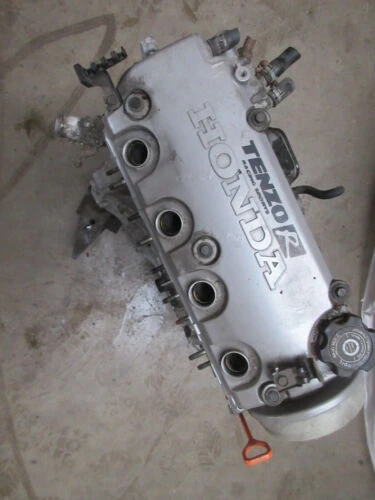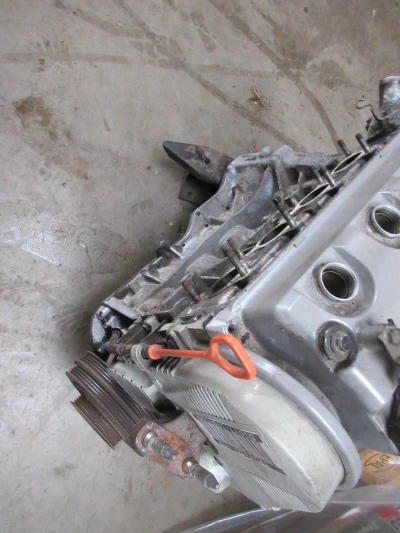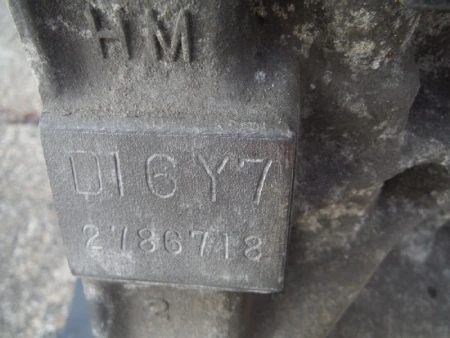The Honda D16Y7 engine is a 1.6 liter, 4-cylinder, SOHC engine produced by Honda between 1996 and 2000 and commonly found in Honda Civics and Del Sols. It offers a great balance between reliability, affordability, and performance. Common problems include timing chain tensioner failure, oil leaks, head gasket failure, and various sensor and valve issues.
In this blog post, we will look at the capabilities, technical specifications, limitations, and known reliability issues of this engine. I will also discuss some of the modifications that can be done in order get more out of the D16Y7.
Understanding The Honda D16Y7 Engine
This section examines the origins and features of the Honda D16Y7 engine, as well as its technical specifications and performance capabilities.

Overview Of The Engine’s History And Development
The Honda D16Y7 engine is a 1.6 liter, 4-cylinder, SOHC engine that was first produced in 1996 for the Honda Civic and later for the Del Sol over its four years of production until 2000.
Over time, Honda made numerous revisions to the original design of their venerable powerplant – introducing several technologies such as VTEC variable valve timing and cylinder deactivation to increase performance while still reducing emissions levels whenever possible.
Technical Specifications And Performance Capabilities
The Honda D16Y7 engine is known for its impressive technical specifications and performance capabilities, making it a popular choice among automotive enthusiasts. Let’s dive into the key specifications that contribute to the engine’s performance:
| Specification | Value |
|---|---|
| Cylinder block material | Aluminum |
| Cylinder head material | Aluminum |
| Fuel type | Gasoline |
| Number of cylinders | 4 |
| Valves per cylinder | 4 |
| Displacement | 1590cc |
| Horsepower | 106 HP @ 6200 RPM |
| Torque | 103 lb-ft @ 4600 RPM |
| Redline | 6800 RPM |
| Rev-Limiter | 7200 RPM |
| Bore | 75.0mm (2.95 in) |
| Stroke | 90.0mm (3.54 in) |
| Firing order | 1-3-4-2 |
| Engine oil weight | 5W-30 |
Here are the cars that Honda equipped with the D16Y7:
- 1996-2000 – Honda Civic DX/VP/LX/CX
- 1998-2000 – Honda Civic Special Edition – SE/EX (Canada)
- 1996-1997 – Honda Del Sol S
- 1996-1997 – Honda Civic Coupé LSI
These technical specifications make the D16Y7 engine a powerful and reliable option for those looking for a high-performance engine. For instance, the engine’s 106 horsepower and 103 lb-ft of torque allow for quick acceleration and efficient power delivery. Additionally, the high redline and rev-limiter ensure that the engine can safely reach and maintain high RPMs, which contributes to its overall performance capabilities.
Furthermore, the engine’s technical specifications can be upgraded and enhanced through various modifications, such as aftermarket parts and professional tuning services. By doing so, users can expect even greater performance from this already impressive engine.
Pros And Cons Of The D16Y7 Engine
So what are some of the plus and minuses of this Honda engine?
Fuel Efficiency And Reliability
Honda’s D16Y7 has served as an example for multiple automotive manufacturers on how a fuel-efficient engine should be designed. Thanks to the Variable Valve Timing (VVT) with the Intake Air Control System (IACS), the D16Y7 is able to develop some serious power even at low RPMS.
As a result of one of the more efficient fuel systems, and fewer parts that translate into greater reliability and reduce maintenance costs, this engine is loved by many.

Power Limitations Compared To Other Engines
As nothing in life is perfect, the Honda D16Y7 engine shows some power limitations when compared to other engines of similar size and design.
This is mainly due to its lower compression ratio of 9.4:1, which means that the engine takes in less air/fuel mixture than higher performance engines as well as lower camshaft duration (246/230 deg).
Additionally, it lacks certain features such as SOHC VTEC or Variable Valve Timing, which are standard features of many modern cars. As a result, users seeking more power may need to consider an engine swap or modifications such as upgrading fuel injection nozzle sizes and changing ECU settings. But we’ll discuss this later in this article.
Potential Issues And Maintenance Tips
The most common issues with this model include timing chain tensioner failure, misfiring, and rough idle caused by worn exhaust manifolds. To ensure that you don’t come across these issues after purchasing or repairing a vehicle with this engine, is it best practice to keep on top of regular maintenance checks such as checking belts, spark plugs, filters etc.
In addition, ensuring any repairs are performed properly according to the manufacturer’s instructions will help keep your car running at peak performance. It’s also good practice after having made major repairs or changes (such as head gasket replacement) to check your fluid levels regularly so that no leaks occur, which may cause further damage over time.
Finally, do not forget the importance of keeping an eye out for signs of wear when inspecting vehicle parts. Regular inspection followed up with prompt repair is key if you want your car running longer without added costs due to breakdowns or replacements being needed later down the line.
Review Of The Honda D16Y7 Engine
Let’s see what some of the users of the D16Y7 think of it.

User Experiences And Ratings
During its production peak, multiple drivers reported good fuel economy, and many automotive journalists at that time rated the D16Y7 as one of the most reliable engines.
The 9.6:1 compression ratio is respectable compared to other engines of its size, while the single overhead cam configuration keeps cost down without sacrificing power output too much – making it an ideal choice for those on a tight budget but still looking for a reliable daily driver or racer car.
Some users have noted that modifications in air intake systems have allowed them to increase throttle response significantly.
Overall, drivers generally agree that even though there could be more power extracted from this modest 1.6 liter SOHC gasoline engine by way of aftermarket parts or professional tuning services if desired – they remain impressed with how efficient and reliable the stock version runs under regular driving conditions. This is largely thanks to Honda’s solid engineering expertise coming from longstanding experience in motorsport competition which Japan auto industry has accumulated over many decades prior.
Comparisons To Other Engines
Let’s see how this engine fares against other Honda engines, the D16Y8 and D16Z6. The table below provides a side-by-side comparison of these engines’ specifications:
| Engine | Horsepower | Torque | Fuel Efficiency |
|---|---|---|---|
| Honda D16Y7 | 106 hp at 6200 RPM | 103 lb.-ft. (140 Nm) at 4600 RPM | 30 City / 38 Hwy MPG |
| Honda D16Y8 | 127 hp at 6600 RPM | 107 lb.-ft. (145 Nm) at 5500 RPM | 28 City / 35 Hwy MPG |
| Honda D16Z6 | 125 hp at 6600 RPM | 106 lb.-ft. (144 Nm) at 5200 RPM | 27 City / 34 Hwy MPG |
As evident from the table, the D16Y7 engine delivers a relatively lower horsepower and torque compared to the D16Y8 and D16Z6 engines. However, it offers better fuel efficiency, making it a more economical choice for those prioritizing fuel economy over raw power.
On the other hand, the D16Y8 and D16Z6 engines pack a higher performance output but with slightly worse fuel efficiency. If fuel consumption is your top priority, it is pretty clear what engine you should pick.
Strengths And Weaknesses
The Honda D16Y7 engine has been praised for its reliability, fuel efficiency, and ease of modification. It produces 106 horsepower with 103 lb-ft of torque, which was quite respectable for its time.
Even today, this can be an ideal choice for commuters looking to upgrade from their stock car engines. It gives enough power to go around town while also achieving excellent fuel economy when driven carefully.
However, there are still some limitations to this powerhouse that should be taken into consideration, such as timing chain tensioner failure, misfiring, and rough idle caused by worn exhaust manifolds.
Upgrades And Modifications For The D16Y7 Engine
The D16Y7 it’s still popular today due to its tuning capabilities. Its users add all sorts of aftermarket parts, from turbo kits to intakes and ECU tuning.
Aftermarket Parts And Accessories
Aftermarket parts and accessories can be purchased for the D16Y7 engine to boost its performance. Popular modifications include camshaft upgrades, forced induction kits such as turbos and superchargers, cylinder heads, exhausts, intakes, and cold air intakes.
Additionally, ECU tuning is a popular way of squeezing more power out of the D16Y7 safely.
Most aftermarket parts come with comprehensive instructions making them relatively simple to install yourself at home, providing you have some DIY mechanical experience. Professional help should always be sought if in doubt when upgrading important engine components like these. You do not want to damage anything.
Professional Tuning And Modification Services
With the right upgrades and modifications, your Honda D16Y7 engine can be tuned to its full potential. Professional tuning and modification services are the way if you can shell out a couple of thousand to get the most out of this baby.
By having an experienced technician inspect, diagnose, and properly tune your engine with upgraded parts and components you can ensure that any potential issues with the stock engine are addressed too.
Additionally, these professionals use dyno-tuning equipment, which allows them to precisely measure changes in power output. This way, they will be able to find that sweet spot where the engine has the greatest power output.
Performance Enhancements
When it comes to enhancing the performance of a Honda D16Y7 engine, there are a few modifications that can have an immediate and measurable impact on horsepower, torque, and overall acceleration capabilities.
Cold air intakes are one of the simplest parts to upgrade on an engine in order to increase power and efficiency. These kits allow a higher airflow into the intake manifold, allowing the engine to breath more easily.
Additionally, 4-1 or 4-2-1 headers allow for improved tuning options as well as more efficient exhaust flow resulting in increased horsepower at higher RPMs.
A Y8 Intake Manifold swap is another excellent way to upgrade your D16Y7 engine by allowing you to adjust compression ratios. This results in greater combustion pressure thus increasing peak power output without sacrificing fuel economy or reliability.
All of these upgrades can net significant improvements in terms of carrying speed between shifts as well as top speed potential when coupled with reworked ECU calibrations or custom tunings from professional shops that specialize in this area here like KPRO III software packages for Hondas fitted with D16Y engines.
It is important however not get carried away with the modifications, especially if you don’t know what you’re doing. It’s always best practice to keep things simple if possible while still achieving solid gains all around.
FAQs:
1. What is the D16Y7 engine?
The D16Y7 engine is a 1.6 liter 4-cylinder variant of Honda’s 16 series engine family that was used in many 1999–2000 model year vehicles, including models of the Honda Civic, CRX and Del Sol.
2. What are some specifications for the D16Y7 Engine?
This engine features an 86mm bore x 86mm stroke measurements as well as 9:1 compression ratio and produces 125 bhp at 6500 RPM and 106 lb-ft torque at 5200 RPM when configured with single point fuel injection system (EFi). Additionally it also offers multi port fuel injection option for upgraded performance ratings of 127 bhp & 108lbs ft torque @ 6600rpm & 5000rpm respectively.
3. How does the overall performance compare to other engines from Honda’s 16 series?
The D16y7 may not appear to be extremely powerful on paper however its reduced displacement lets it rev faster than other motors in similar classes making it very efficient in city driving environments without compromising power output overall – resulting stable mile per gallon ratios combined with respectable acceleration capabilities when compared against competition within same trim level offerings!
4. Are there any major known problems associated with this motor?
The most common issues experienced with this particular motor tend to involve head gasket failure due to improper catalyst assembly whilst block deformation tends occur unexpectedly due over-stressing during long drives or abrupt changes in gear shifts/pressures caused by driver interaction/operational habits – both can result functional deterioration if left untreated which is why proper maintenance must be taken into consideration maintain optimal functionality throughout its lifespan!
In Summary
Overall, the Honda D16Y7 engine provides an excellent balance between reliability and performance. With a compression ratio of 9.4:1 and 106 horsepower at 6200 RPM, this engine is well-suited for city driving, as well as cruising on the highway.
What makes it even more desirable is the great number of modifications that can be added to achieve greater performance, while keeping the fuel consumption low.
Sources
Honda D16 Engine – Everything You Need To Know
Guide to tuning the D16 engine
Engineering Coordinator with 5+ years of experience in the automotive manufacturing industry. Currently supporting vehicle development and new model launch activities at Honda Development and Manufacturing of America. Skilled at managing engineering teams, overseeing prototype builds, coordinating testing, and driving continuous process improvements. LinkedIn








